MOST IMPORTANT NOTE: Traders who enter and exit based on 5 minute candles are scalpers. They trade to make small profits.
Note this:
Your brokerage would typically be Rs 20 to Rs 50 per lot PLUS Taxes.
NOW – in one lot you would end up paying up to Rs 500 as brokerage (100) and taxes (400).
Therefore, to breakeven per lot, you’d need a movement of 7 points minimum.
If you sell before that, you lose.
If you make a loss, you lose capital + brokerage + taxes.
Therefore, if you are uncomfortable with this 5 minute strategy, ditch it and move on to more reliable and longer 15-minute and 30-minute strategies that I will blog about in the days to come.
Risk takers who want to persist with this strategy, please read on:
Rules of Trading 5 Minute Candles
- This trading works best for Indices, mostly the Nifty and Bank Nifty.
- This is an Intra Day Strategy
- You can apply it to extremely liquid FNO stocks such as Reliance, but do not apply it to FNO stocks where the spreads are high (MRF, Shree Cement, SRF, etc.) or where the volumes are low (Grasim).
- This strategy will not work on cash stocks.
- You have to be extremely agile and always watch the charts while holding a position.
- Be quick in booking your profits or losses because you will get quite a opportunities during the day.
- You will need a minimum 5-7 point movement to breakeven.
Now, to understand this strategy, you must focus and observe.
TRADING THE 5-MINUTE CANDLES
You will have to setup:
- VWAP (learn it here) (Primary indicator)
- EMA Cross (5 period/12 period) (many folks 5 period/8 period – so you can paper trade and decide which one is better) (Primary Indicator)
- RSI (14) (Secondary or Confirmatory Indicator)
- Volumes (Secondary or Confirmatory Indicator)
STEP A: SETUP THE VWAP AND AND OBSERVE THIS NIFTY CHART (from 18 June 2018 to 22 June 2018)
What we can easily figure out is this:
A. When the price decisively breaks the VWAP, the Nifty goes into a free fall.
B. The price decisively crosses above the VWAP and the Nifty scales up.
C. When the price decisively breaks the VWAP, the Nifty falls.
C-D. Notice that the Nifty rises in this phase, but is still below the VWAP.
D. The price breaks the VWAP, the Nifty falls for a few candles.
E. The price rises above the VWAP, and this time the rise is relentless.
The observations are:
- What is sure is that when price rises or falls below VWAP, it leaves profits on the table so long we take the correct action.
- There are up and down spikes in between A-B-C-D-E. But since the price is above or below the VWAP, there is no way of figuring out these movements UNLESS there is another indicator that helps us figure these out.
- There is no way of telling how long a rise or fall will last unless we are helped by another indicator.
Therefore, let us know plot the EMA Cross (5-12) and the RSI.
STEP B: SETUP THE CHART USING VWAP, EMA CROSS AND RSI
Please open the VWAP chart above in a separate window as you will have to correlate. Let’s start:
On 18 June 2018, when the price fell below the VWAP, the 5 period EMA crossed below the 12 period EMA and the RSI too fell to 39.96. The volumes too were above the 20 Day MA.
Bearishness was confirmed by all 4 indicators.
A short trade was confirmed.
Between Phases there was no significant EMA crossover till 20-6-18 at 10.35 AM.
On 20 June, at 10.35, the 5 Period EMA crossed above the 12 Period EMA. At this time the price was below the VWAP.
The RSI too started rising.
Within 15 minutes, the price crossed the VWAP and went on to head much higher.
In this case the EMA gave a signal in advance.
Let’s check what happened on 21-6-18
On 21 June, at 9.25 AM, the price fell below the VWAP, and after 15 minutes the 5 Period EMA fell below the 12 Period EMA.
The RSI too started falling.
In this case the VWAP reading gave a signal in advance.
Okay, by now you would have got the point and I won’t get into checking in between phases any more because you can do that by setting up the chart. Let’s flesh out the trading strategy:
THE 5 MINUTE CANDLE TRADING STRATEGY (FINAL POINTS)
- The VWAP and EMA are the primary indicators to follow. RSI is secondary – it confirms the trend. Volumes are average-important for this strategy.
- When the price rises or falls above or below the VWAP, the movement continues for at least 10+ candles (50 minutes) as we have seen in the example above. But this is not a must. In Phase A, the fall includes 80 candles, BTW.
- The EMA Cross, another primary indicator, also clues traders on to entry and exit points. It can provide clues before, after and in-between the stages in which the price crosses above or below the VWAP.
- Spiking volumes at any stage can provide vital clues. For example, on 22-6-18 at 11.50 AM, the volumes spiked when the price was above the VWAP. The EMA crossover happened as well, and thereafter the prices started spiking.
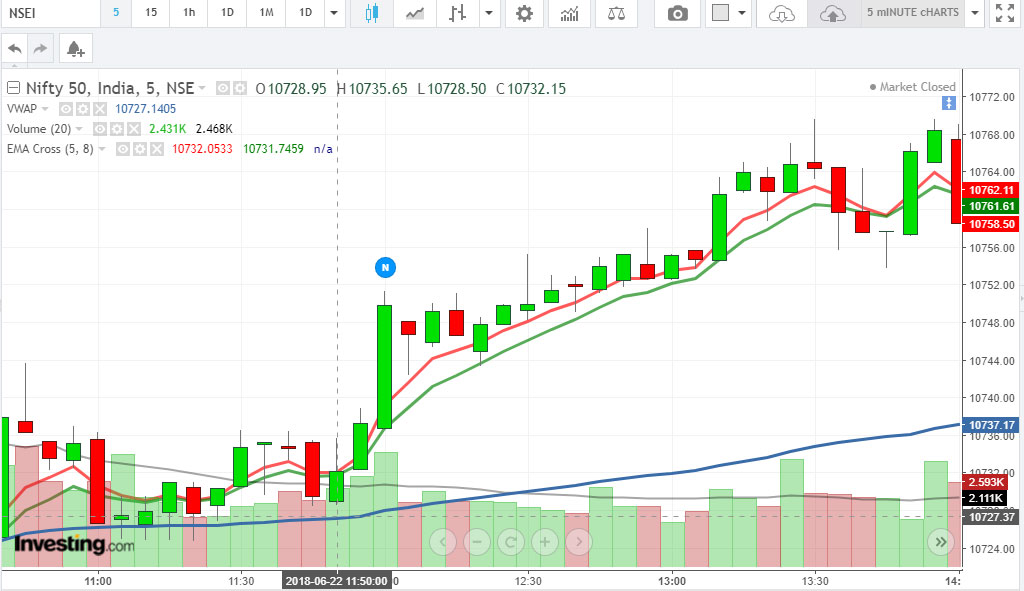
- The RSI should be used to confirm the EMA/VWAP signals.
- All trades should be squared up intra day. You should be happy with small profits or losses.
This is it. Use this guide and perform paper trades and see for yourself whether this strategy works for you. I also have kept this simple and not included other indicators because this strategy works.
Finally, remember that every trade setup can fail and therefore please follow this advice:
This is for ALL traders:
A good setup has 60%-80% chance of winning
So, in 10 trades, the worst case is
LLLLWWWWWWErgo, allocate trading capital factoring in the worst
Your first trade can be 5% of trading capital, 2nd can be 10%, etc.
NEVER STAKE ALL ON 1 TRADE
— Sunil Tinani (@TheBullBull) June 25, 2018

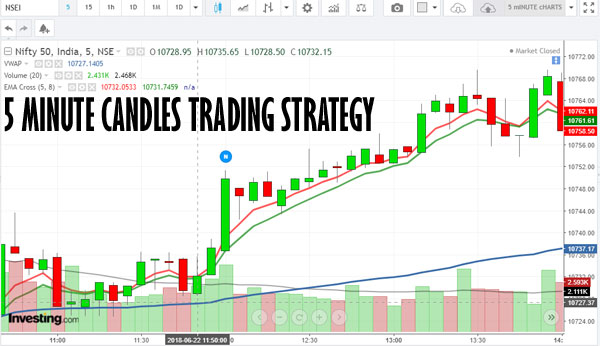
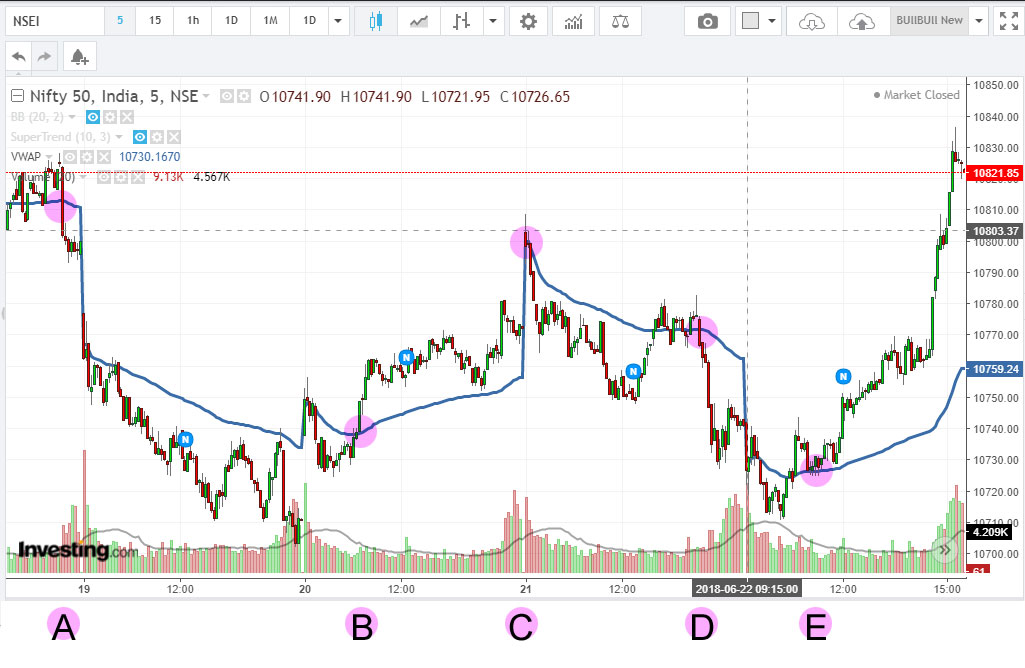
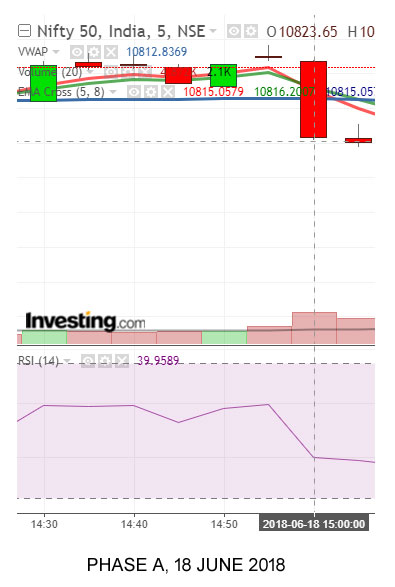

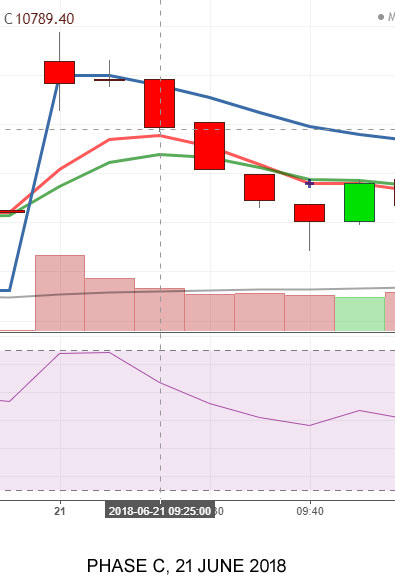
Great Master of TA.
very useful. quite interesting. thanks
Sunilji just a request.. it would be of great practical help if you make a youtube video showing all d indicators n setting used.
Very Good and well explained Sunil Jee.
Thanks a lot.
Amazing
What should be the risk reward ratio in this trade setup?
Nicely and aptly explained thank you sir. Sir what is in your opiNion will be the expiry or tomorrow be like , when you see data of OI of all major shares in nifty has increased by 2% to 5% . 10700 is a support can be a pull back be achieved vis short coverings (wrt OI)
Well explained…
Thank you so much.
Really i improvised my trading knowledge through this site.
you gave me confidence to trade on my own.
Will experiment in my paper trade.
Thank you sir.
good info for beginers
Sir thanks a lot for your great effort.How to set up stop-loss and what is the risk reward ration pls through some light.
For Risk-Reward Ratio check the tweet at the end of the article.. assuming a 60% success rate, the worst case will be that your first 4 out of 10 trades will not work.. so worst RRR is 100:0 for the first 4 trades. Work on that probability and allocate your trading capital accordingly.
Thank you. Sir, what would be the trigger for stop loss exit , is it based on indicators turning negative or on levels. Kindly clarify
On indicators turning negative
Sir thank you for a very nice way to take trades. I have few questions: 1. When VWAP is there we need not refer to volume ? 2. When VWAP is horizontal , we should not be taking trade?
1. Sometimes prices are manipulated with very low volumes traded. When VWAP is sideways, it may not fall much when such an event occurs. Therefore watching volumes per candle also helps.
2. When VWAP is horizontal and price too is horizontal, then you can avoid. Recent example from 21-24 June 2018: Vedanta
Sir, thank you for the post! I had tried the 5 minute candles on the Bank Nifty today and at about 1:26pm I identified the market to be going down @26,215 (price cut below VWAP, RSI below 50, 5ema cut below 12ema and had decent volume on sell)…but the index did not move below 26205 but rather moved on the upside…can you kindly clarify what would have led to my false judgement here? The CPP was near 26220, was it this support that nullified the other indicators? Or did I miss out on reading the candles better? Or……thank you!
Actually all indices are being managed, and one can never say what stock will be used to pull the index up. It is better to move to a 15M or 30M system.
Sir, thank you for the suggestion! I did try the 15M charts today and I felt it does make a difference. Also thank you for the post on MACD…along with the indicators above I had added MACD 1HR…just sharing my observtion – all indicators pointed bearish in the morning except MACD 1HR which was neutral with a bullish bias and eventually the BankNifty turned positive. I hope I can extrapolate this reliability on MACD 1HR. 🙂
Hi Team,
This information is very informative and Thanks for sharing…
Hello Sir
Really helpful information. thanks for it.
Thank you very much. All the facts explained by you are very simple and easy. If you are find Stock Market Advisor then Visit http://www.ShareTipsInfo.com